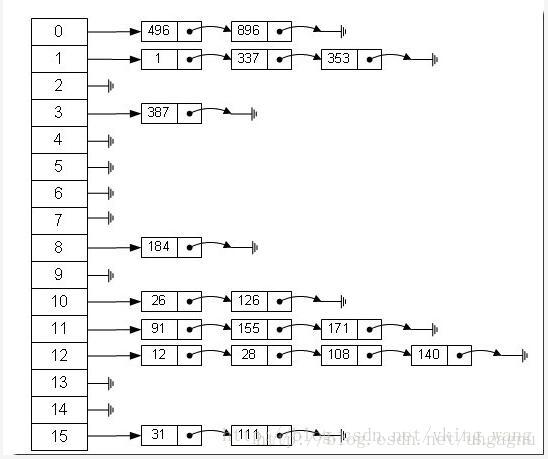HashMap的底層原理
阿新 • • 發佈:2017-09-06
this array pac ont effect [] trie threshold logs
簡單說: 底層原理就是采用數組加鏈表:


兩張圖片很清晰地表明存儲結構:
既然是線性數組,為什麽能隨機存取?這裏HashMap用了一個小算法,大致是這樣實現:
// 存儲時:
int hash = key.hashCode(); // 這個hashCode方法這裏不詳述,只要理解每個key的hash是一個固定的int值
int index = hash % Entry[].length;
Entry[index] = value;
// 取值時:
int hash = key.hashCode();
int index = hash % Entry[].length;
return Entry[index];
public V put(K key, V value) { if (key == null) return putForNullKey(value); //null總是放在數組的第一個鏈表中 int hash = hash(key.hashCode()); int i = indexFor(hash, table.length); //遍歷鏈表 for (Entry<K,V> e = table[i]; e != null; e = e.next) { Object k; //如果key在鏈表中已存在,則替換為新value if (e.hash == hash && ((k = e.key) == key || key.equals(k))) { V oldValue = e.value; e.value = value; e.recordAccess(this); return oldValue; } } modCount++; addEntry(hash, key, value, i); return null; } void addEntry(int hash, K key, V value, int bucketIndex) { Entry<K,V> e = table[bucketIndex]; table[bucketIndex] = new Entry<K,V>(hash, key, value, e); //參數e, 是Entry.next //如果size超過threshold,則擴充table大小。再散列 if (size++ >= threshold) resize(2 * table.length); }
get() public V get(Object key) { if (key == null) return getForNullKey(); int hash = hash(key.hashCode()); //先定位到數組元素,再遍歷該元素處的鏈表 for (Entry<K,V> e = table[indexFor(hash, table.length)]; e != null; e = e.next) { Object k; if (e.hash == hash && ((k = e.key) == key || key.equals(k))) return e.value; } return null; } null key的存取 null key總是存放在Entry[]數組的第一個元素。 private V putForNullKey(V value) { for (Entry<K,V> e = table[0]; e != null; e = e.next) { if (e.key == null) { V oldValue = e.value; e.value = value; e.recordAccess(this); return oldValue; } } modCount++; addEntry(0, null, value, 0); return null; } private V getForNullKey() { for (Entry<K,V> e = table[0]; e != null; e = e.next) { if (e.key == null) return e.value; } return null; } 再散列rehash過程 當哈希表的容量超過默認容量時,必須調整table的大小。當容量已經達到最大可能值時,那麽該方法就將容量調整到Integer.MAX_VALUE返回,這時,需要創建一張新表,將原表的映射到新表中。 /** * Rehashes the contents of this map into a new array with a * larger capacity. This method is called automatically when the * number of keys in this map reaches its threshold. * * If current capacity is MAXIMUM_CAPACITY, this method does not * resize the map, but sets threshold to Integer.MAX_VALUE. * This has the effect of preventing future calls. * * @param newCapacity the new capacity, MUST be a power of two; * must be greater than current capacity unless current * capacity is MAXIMUM_CAPACITY (in which case value * is irrelevant). */ void resize(int newCapacity) { Entry[] oldTable = table; int oldCapacity = oldTable.length; if (oldCapacity == MAXIMUM_CAPACITY) { threshold = Integer.MAX_VALUE; return; } Entry[] newTable = new Entry[newCapacity]; transfer(newTable); table = newTable; threshold = (int)(newCapacity * loadFactor); } /** * Transfers all entries from current table to newTable. */ void transfer(Entry[] newTable) { Entry[] src = table; int newCapacity = newTable.length; for (int j = 0; j < src.length; j++) { Entry<K,V> e = src[j]; if (e != null) { src[j] = null; do { Entry<K,V> next = e.next; //重新計算index int i = indexFor(e.hash, newCapacity); e.next = newTable[i]; newTable[i] = e; e = next; } while (e != null); } } }
HashMap的底層原理
